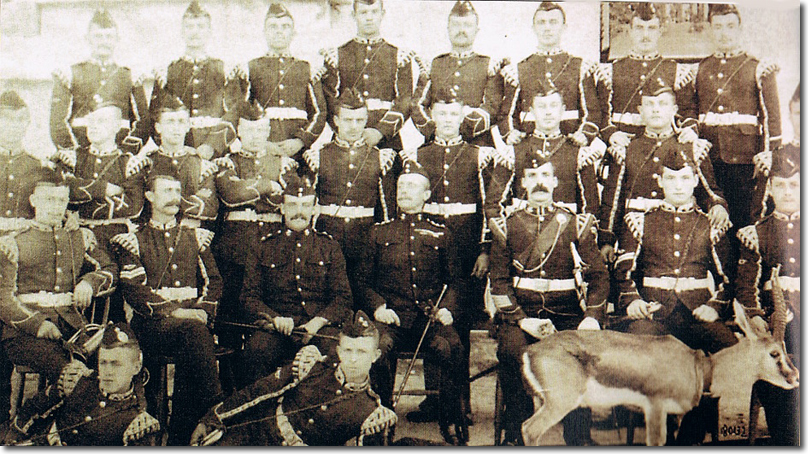|
|


|
|
The bugle was first used by light infantry in the British army towards the end of the 18th century. The drum which was the traditional method of transmitting orders in the infantry proved ineffective for troops spread out for the work that light troops had to do. So the bugle was adopted and became the badge of the light infantry. The bugle was soon used by all infantry regiments and the buglers multi-tasked as drummers, fifer and buglers. They were grouped together in the regiment as the Corps of Drums and played in conjunction with the band but were separate from them. In the light infantry the buglers remained buglers and did not adopt the drum until the 20th century.
This photo, taken in Aldershot in 1890 shows the buglers of the 1st Battalion posing with the CO, Colonel Hallam Parr and the adjutant. The men are wearing an undress version of their tunic. It has 5 buttons down the front instead of 7 and has no white piping on the edges. The shoulder wings are similar to those on the dress tunic and there is the white tape down the front and back of the sleeve with repeating red crowns. There is a bugle badge sewn on the upper right arm instead of the drum badge worn by non-light regiments. The collars and pointed cuffs are blue, the collar having the top edge covered by the tape, and the cuffs edged with red and white cord. The Sergeant-Bugler sits next to the CO. He has a crimson sash on his left shoulder with whistle attached. And his badge of rank is worn only on the right sleeve, as with the other NCOs. He has gold lace on his collar and wings, and a gold braid edge to his tunic. Green cords and tassels are attached to the bugles which are strung over the left shoulder. Being a royal regiment they were entitled to the royal colours for these cords, but as light infantry they retained green. They wear the glengarry cap, replaced around 1894 by the field service cap. The badge is the stringed bugle with a mural crown, although the young man at the bottom left of the picture has the old style glengarry badge which was the centre of the star plate on the helmet. The animal should be mentioned as it was their mascot at the time. The antelope was probably brought back in 1880 from the battalion's tour of duty in South Africa. Like other regimental mascots it was under the care of two of the buglers. |
Regimental Details | Musicians and Drummers
Armed Forces | Art and Culture | Articles | Biographies | Colonies | Discussion | Glossary | Home | Library | Links | Map Room | Sources and Media | Science and Technology | Search | Student Zone | Timelines | TV & Film | Wargames